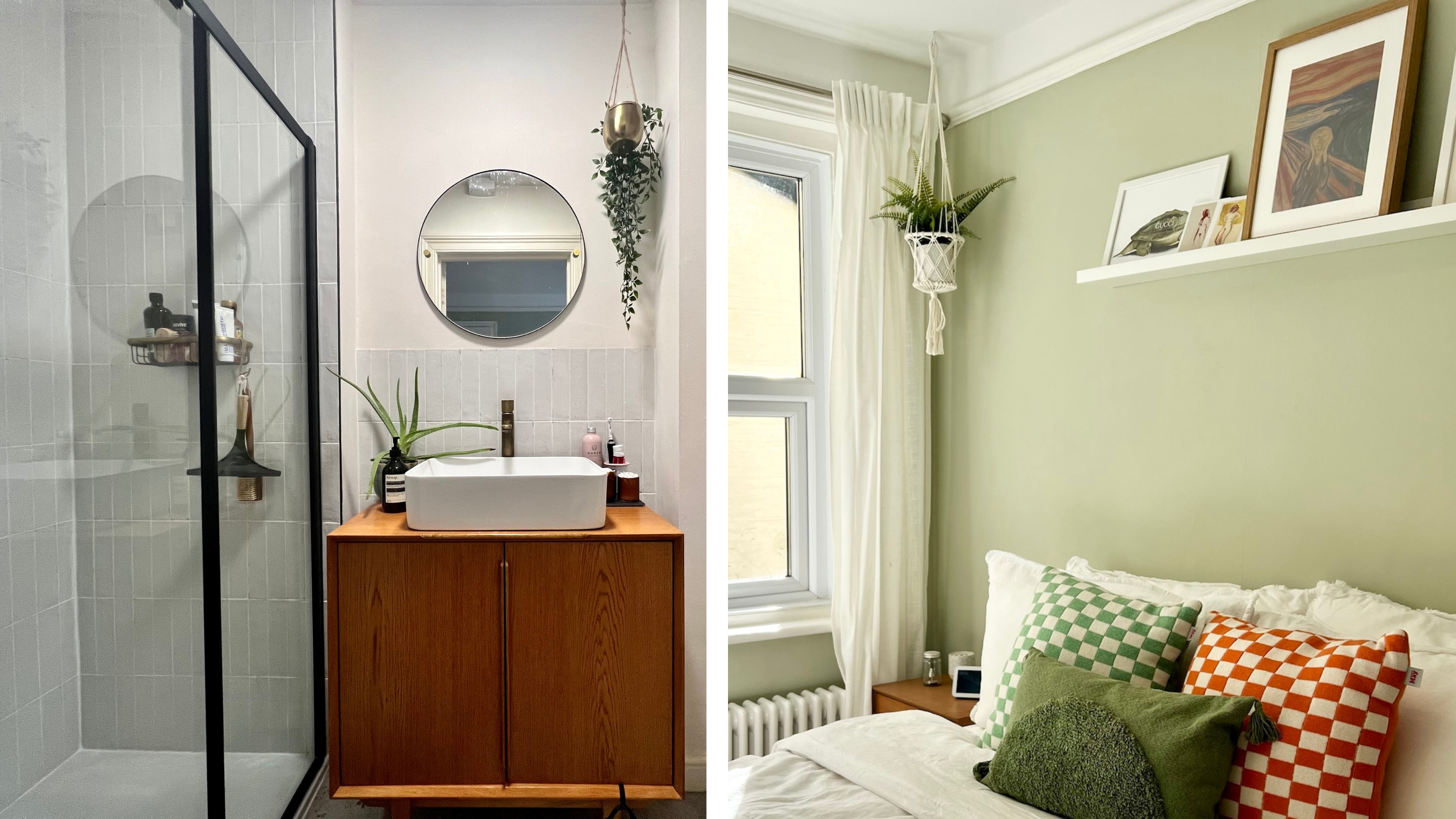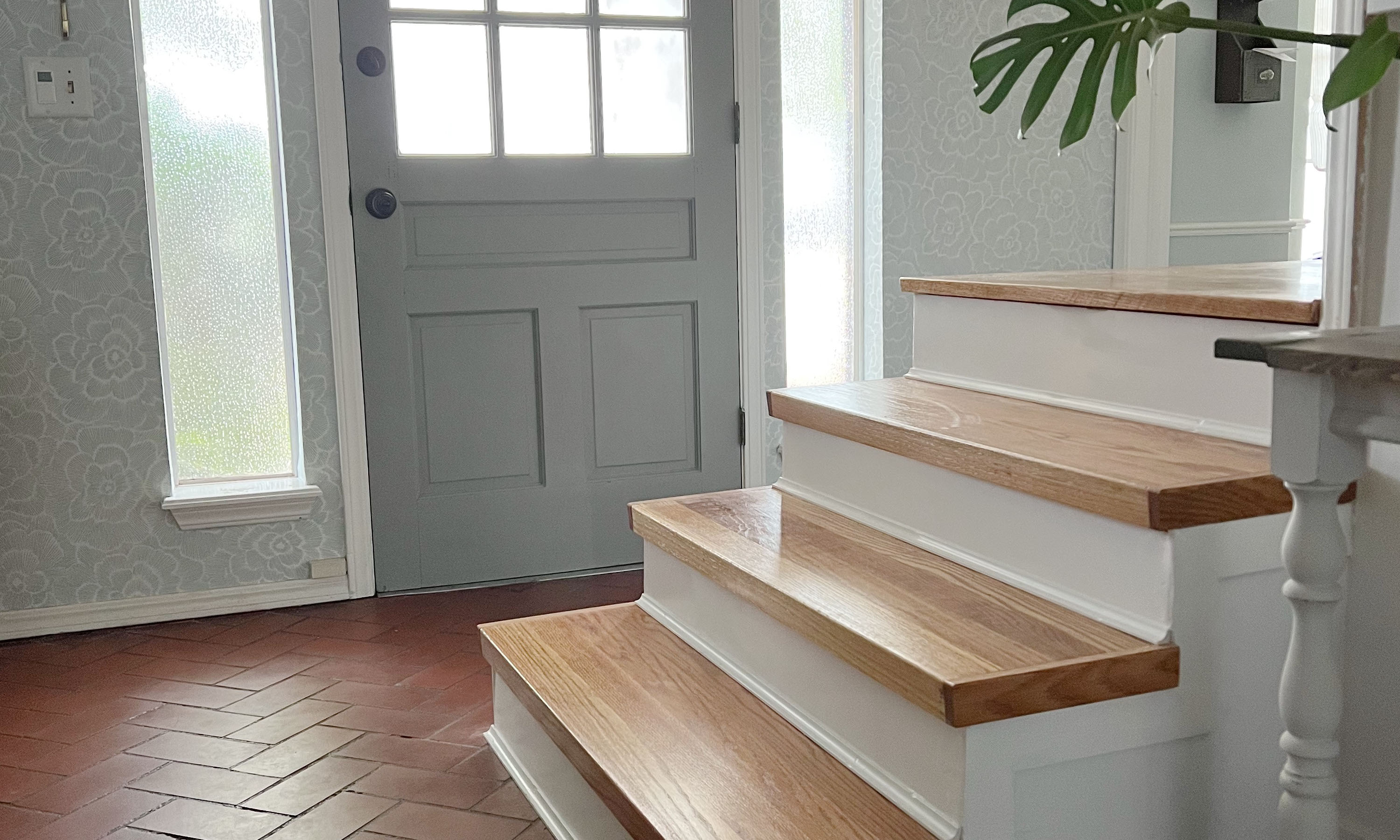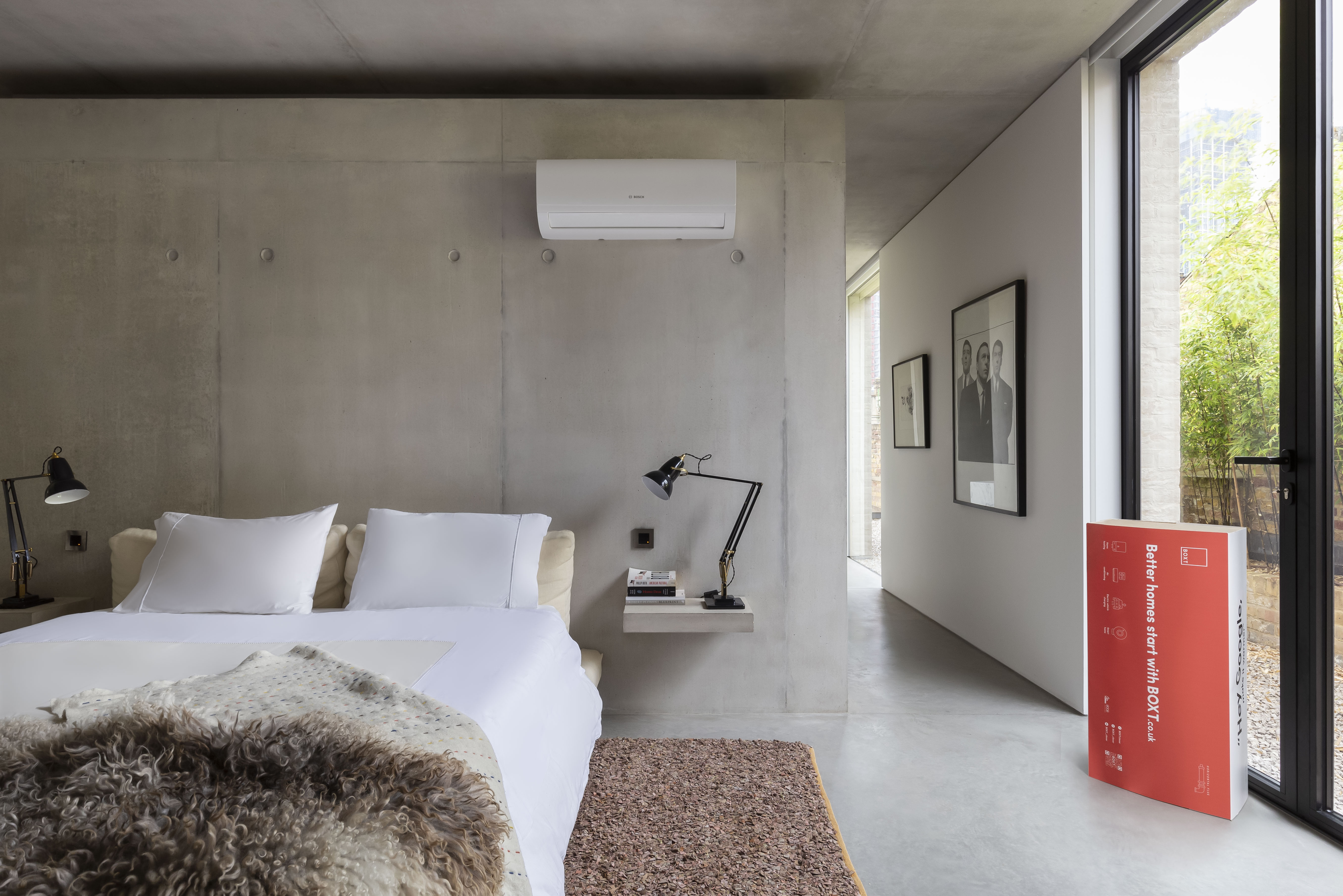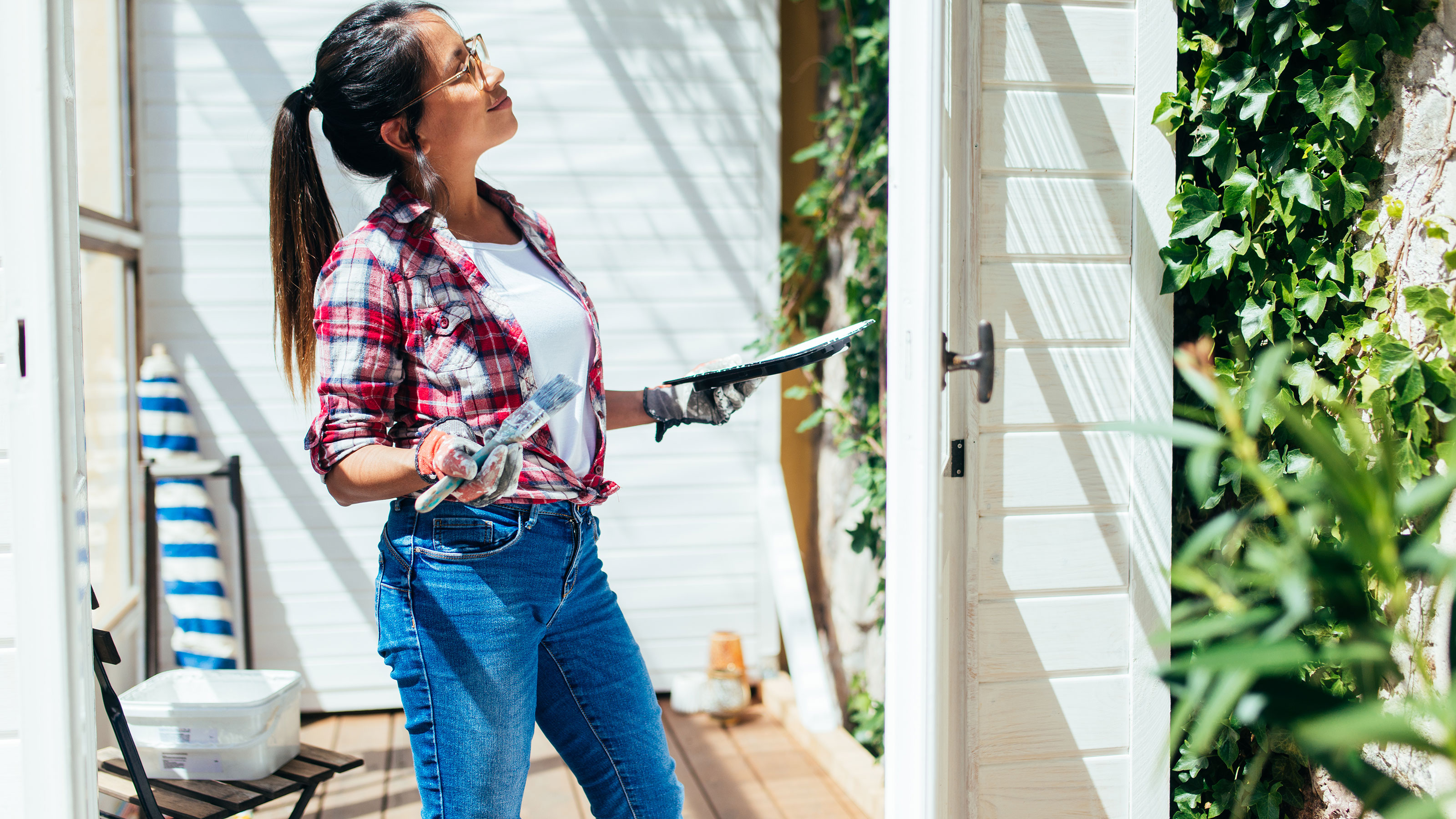

If you want to freshen up a space and give it new life, painting a room is a simple and effective edit. Whether you literally want to go over the walls in white or if painting is part of a bigger home transformation, it's an easy project that can be quick to do and easy on the budget – if approached in the right way.
You'll save a ton by going down the DIY route for sure, but if you don't have time or if you’re just not handy with a paintbrush, you may choose to leave the job to the pros. In this post, we’ll look at the average cost to paint a room, the factors that influence that cost, and other things to consider before tackling this home renovation project.
What's the average cost to paint a room?
Professional painters calculate the charge of painting a room by measurements, cost of the paint, the complexity of the project, and timing, according to Matt Kunz, president of Five Star Painting, a Neighborly company. “We take the guesswork out of pricing by using our software package to determine the best pricing for the homeowner,” he says.
If you want a ballpark to start the planning process, Bailey Carson, home care expert at Angi, says, “The average cost to paint a room is $525, including labor and materials.” But if you DIY the job, she says you can do it for about $100. Of course, the final cost would depend on the size of the room, among other factors. Otherwise, the following chart shows an estimated cost to paint a room by its size.
COST TO PAINT A ROOM BY SQUARE FOOT
These prices are estimates based on ranges secured from professional painters. Including ceilings will add to the cost.
| Size of the Room | Approximate cost to paint |
|---|---|
| 10x10 | $400 |
| 10x12 | $480 |
| 12x12 | $576 |
| 12x14 | $672 |
| 14x16 | $896 |
Of course, the size of the room isn’t the only thing that goes into the cost of painting. If you hire a professional mover to empty the space, their services will increase the price. If you live in an older home that requires a lead test, that’s another expense. Other common factors that influence cost include:
- Height of the ceilings
- Condition of the walls
- Number and size of windows and doors
- How many colors you want to use
- Cost of the paint
- Cost of other materials
- Labor charges
Cost of paint and other materials
Like all building materials, there are cheap, inexpensive, and quality paints to choose from. Is there a difference? Yes. “High-end paints like Sherwin Williams and Benjamin Moore are definitely worth the money,” says Britney Johnson, owner of B-Design interior design firm in Olympia, Washington, and instructor of the Design Your Dream Home online course. According to her, “you will almost always get better coverage and a richer color” with high-end paint. She even says that using the most inexpensive option from a top brand will bring better results than cheap paint. “Painting with cheaper paint is harder too; it's often runnier causing more drips and runs,” Johnson says.
You might also notice a price difference between sheens of the same paint. But not very much, if you compare within the same brand. For example, you may pay $5-10 more for a gallon of semi-gloss versus flat paint. But, it’s essential to use the correct sheen for the job.
'To DIY this project,' says Carson, 'you’ll also need rollers, brushes, buckets, drop cloths, primer, and other materials.' And that’s provided you don’t have repairs to make that require scrapers, sandpaper, or spackling. Overall, the cost of these items can add 20-30 percent of the paint cost to the cost of the job. Ensure you pick up the best paint roller for the job of course.
How to calculate the amount of paint you need
Before setting your budget and shopping for paint, you need to know how much to buy. For a rough estimate, add the length of all the walls to be painted, from corner to corner, to get the room's perimeter. Multiply that number by the height of the walls from floor to ceiling to get the square footage. Then, divide the square footage by the coverage of one gallon of paint (found on the can). The answer is how many gallons you’ll need of the chosen paint to cover the walls with one coat.
The coverage of paints varies by type, sheen, and manufacturer. The average is 400 square feet per gallon. Also, this estimate doesn’t consider the area taken up by doors and windows, the ceiling, primer, or any accent colors. So, if the calculations seem too cumbersome, you may find using a paint estimating calculator helpful.
Pros and cons of hiring a professional
Many homeowners find painting an easy DIY project. Some even consider the process therapeutic and gratifying. But if you don’t agree, hate the mess, or otherwise wish someone could come in and take care of it for you, you’re not alone, either. 'The quality of the paint job will depend on the quality of the painter, so if you want to ensure the room will be flawless, without streaks, gaps, or any uneven areas, it’s best to leave it to the experts,' says Carson. So, if you’re struggling with this decision, here are some pros and cons of hiring a professional painter.
Pros:
- Professionals already have all the tools
- They get the job done faster
- A professional will do a better job
- They take care of moving the furniture
- They clean up after themselves
- A professional saves you time
Cons:
- You may have to wait to get on their schedule
- You have to pay for their labor
Pro tips for the DIY painter
If, after balancing the pros and cons of hiring someone to paint your room for you, you still want to do it yourself, here are a few tips Kunz offers for the DIY painter.
- To help you choose between several colors, paint them on separate pieces of full-sized cardstock and place them on different walls in changing light.
- Use a lightweight spackle to fill small nail holes.
- Remove the switch plates.
- Dust baseboards and trim and carefully mask with good painters’ tape.
- Prime dark-colored walls before covering with a lighter shade.
- Always use two coats of the topcoat.
- Be generous with your use of fabric drop cloths.
Other considerations when painting
Painting takes time
When painting a wall or entire room yourself, what you save in money you spend in time. According to Johnson, the average time to paint a 10x12 room with two coats is 6 - 10 hours. Of course, that depends on the amount of trim work and your experience level. You’ll also have to move all the furniture yourself or hire someone to do the heavy lifting for you. According to Kunz, a professional painter moves or covers the furnishings so you don’t have to.
While you're at it
While the furniture is out of the way and you’re already in home improvement mode, take this time to make a few more upgrades. Now is the perfect time to replace beat-up baseboards, install crown molding, install new switches, outlets, and plates, replace hardware, or hang new window treatments.
Accent walls
Painting one wall a different color generally costs more because you’ll have to buy an entire gallon for the wall, and you won’t use all of it. So, if you want an accent wall, add the price of one more gallon. If you're going to apply other types of texture to the wall like beadboard, shiplap, wallpaper, or even stucco, you’ll have to add the cost of those materials, too.
QUESTIONS TO ASK A PAINTING CONTRACTOR
If you’ve decided to hire a professional, it’s essential to vet the company you work with. To find someone you can trust, ask friends and neighbors for recommendations. Once you have a couple of contractors to call, here are a few questions you want to include in your conversation.
- Are you insured?
- Do you offer financing?
- When can you start?
- Do you roll or spray the paint?
- Will you provide all your supplies?
- Do you purchase the paint, or should I?
- Can I get a discount if I provide supplies?
- Do you expect me to empty the room of furnishings?
- What steps do you take to protect my furnishings?
- Do you charge by the hour or the square footage?
Painting a room can be a rewarding experience, but it’s not everyone’s favorite thing to do. If the thought of painting makes you want to run for the hills, you’ll save time and prevent headaches by hiring a professional. Either way, the facelift will increase your home’s value and make coming home a joyous experience.
Join our newsletter
Get small space home decor ideas, celeb inspiration, DIY tips and more, straight to your inbox!
Carol J. Alexander writes website copy, blog posts, and feature articles on home remodeling and construction topics from her home in the Shenandoah Valley of Virginia. In addition to Real Homes, notable clients include, This Old House, Family Handyman, and Florida Roofing magazine.
-
 My first apartment makeover: 5 renovation mistakes I learned the hard way, and how you can avoid them
My first apartment makeover: 5 renovation mistakes I learned the hard way, and how you can avoid themThese are 5 things to avoid in your apartment makeover. Trust me, I learned these the hard way during my first renovation project
By Luisa Rossi
-
 Share your small space glow up to win $150 in the Real Homes competition
Share your small space glow up to win $150 in the Real Homes competitionShow off your creativity and DIY skills to win $150 and for the chance to be featured exclusively in Real Homes magazine
By Camille Dubuis-Welch
-
 My DIY range hood and backsplash build gave my kitchen the perfect farmhouse finish
My DIY range hood and backsplash build gave my kitchen the perfect farmhouse finishI craved charm in my kitchen space and adding a custom range hood and shelving was the best move.
By Brooke Waite
-
 How to convert carpeted stairs to wood treads: a 5-step DIY
How to convert carpeted stairs to wood treads: a 5-step DIYConvert old worn-out carpeted stairs to wood treads DIY for a beautiful finish that will last for years to come. Plus, this stair riser project will cost a fraction of the price to pay a pro!
By Dori Turner
-
 AC not working? Here are 8 things to check ASAP according to industry experts
AC not working? Here are 8 things to check ASAP according to industry expertsYour AC may not be working because the filter is clogged or you've got a tripped circuit breaker. Whatever the issue, getting to the root of the problem will lead to quicker solutions
By Camille Dubuis-Welch
-
 3 DIYs you should NOT do in a heatwave
3 DIYs you should NOT do in a heatwaveYou shouldn't clean windows on a hot day, you just shouldn't
By Camille Dubuis-Welch
-
 HGTV home renovator shares the most essential home repair you can do
HGTV home renovator shares the most essential home repair you can doHGTV's hottest renovator Carmine Sabatella debunks why this basic home maintenance job should not be forgotten
By Camille Dubuis-Welch
-
 15 telltale signs you're dealing with a cowboy builder and how to avoid them
15 telltale signs you're dealing with a cowboy builder and how to avoid themA cowboy builder is easy to spot, when you know the telltale signs. Here's how to avoid one so you don't end up out of pocket with a poor or even unfinished home reno job
By Lucy Searle